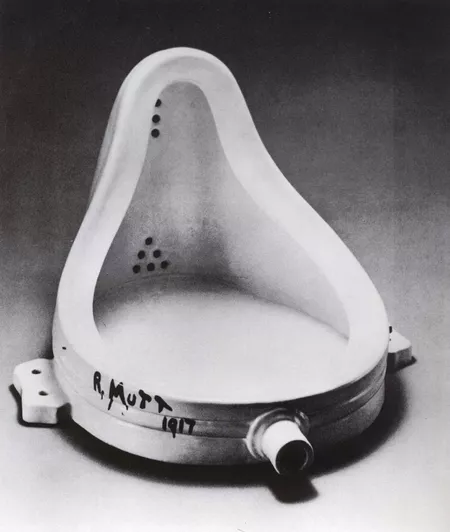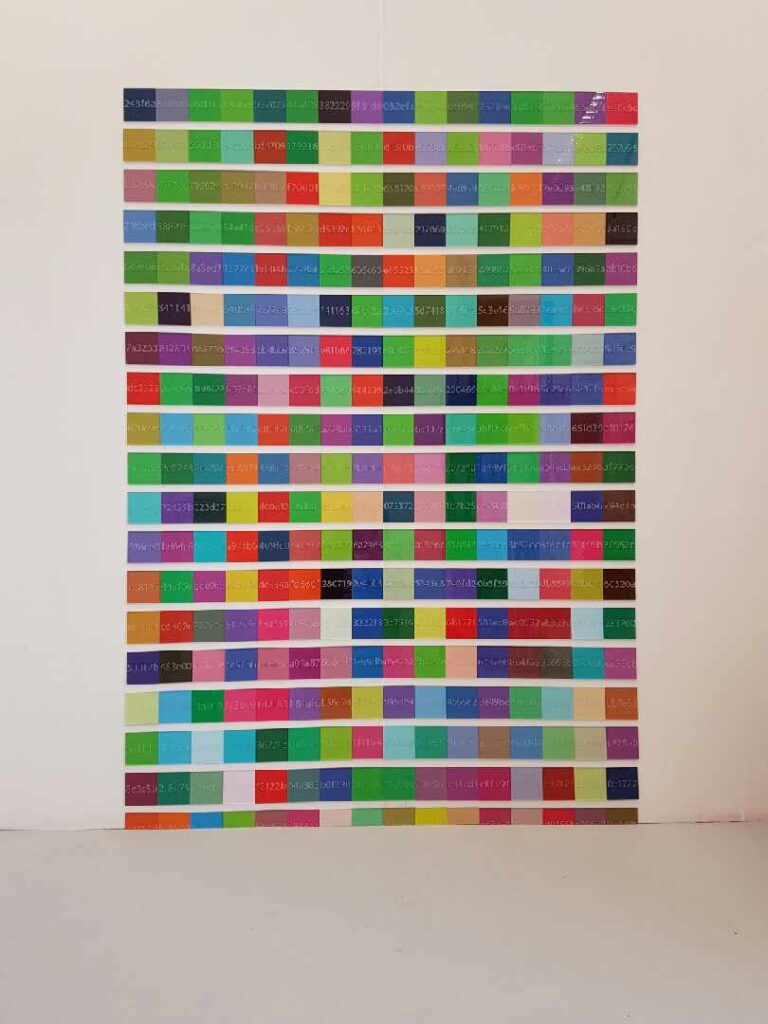- Feb 3, 2024
- LitBits
- 0
New blog post by Vagabond Heart – discussions in this thread, please
---
Marcel Duchamp said this: it’s art if I say so. He’s the guy who stuck a urinal on the wall and called it ‘Fountain’. And ever since he did that, the art world swivelled on its axis and became a place where apparently anything goes. And usually for a gazillion quid. Which really gets the goat of your average person on the street.

How many times have you heard someone look at a pice of contemporary art and say, ‘my kid could paint that’ ? And, you know, it’s hard to argue with that kind of logic. Because I’m an artist and sometimes even I look at stuff and think, ‘seriously?’
But I’ve come to believe it’s not art that’s the problem but the language we use to describe it.
Take music. We have composers, performers, classical artists, opera singers, pop musicians, tribute bands, and me singing along to the radio in my flat when the neighbours are out. We differentiate, for instance, between the people who wrote the songs (one particular skill set) and those that performed the songs (an entirely different skill set).
We also have labels for different styles of music, and recognise distinct levels of complexity. We don’t compare Mozart to someone singing Abba on a karaoke night down the local pub. Nor do we think that our darling eight-year-old’s new-found skills on the recorder is on same level as a concert by Lady Gaga. Yet all of these things come under the banner of music.
So, we have a language that separates composer from performer, and Country and Western star from Rapper or DJ. When it comes to music we have all the words.
But when it comes to art we have, er, artist. Yeah. That’s about it. And I think it may be this lack of language that stops us appreciating what goes into the making of Contemporary or Modern Art.
The title we give someone who creates something never before seen (think Picasso, for instance) is artist. The person who draws a fairly decent horse that is coped from a photograph is called the same. Nothing separates the person who created a new way of looking at something from the person who competently copied a Disney character onto their child’s birthday card. They are both just artists.
Therefore, we have no title that specifically acknowledges someone whose mastery of the craft, and creative genius, has revolutionised how we see things for generations to come.
So, let me introduce the idea that photography changed that art world more than any other invention.
Before photography, a large part of the art world was about getting someone to recreate an accurate (and preferably flattering) image of something or someone that already existed. The people with money wanted to show off their beautiful houses, their trophy wives, their perfect children. And who can blame them?
But once photography really took hold, this act of accurate representation was more clearly accomplished by the new media.
And art was finally free to be something else entirely.
It had always sneaked in under the radar, of course. Art was always about how the artist perceived their subject, and what they chose to show or not show. Hence a Goya looks nothing like a Renoir.
But they’d still had to pay the rent, so they’d still had to paint what the rich people wanted to hang on their walls.
Now, suddenly, art could be about ideas, thoughts, feelings, protest, and significance. Art could be an expression of what the artist wanted to say. It finally got to catch up with how music had been all along.
I’ll give you an example of how this way of thinking about art works, from my own experience.
I’m old, so I was raised in the 1970’s, where the pinnacle of art was still seen as being able to represent something as finely as a photograph. Landscapes, still lives, portraiture – these were the pillars of my learning about art.
But I finally got to study art at university when I was in my late fifties, and oh boy had it changed. I pretty much had to un-learn everything I thought I knew and start over.
But I did the work and for my degree show I became fascinated by the subject of colour. I’m slightly obsessed with colour actually. I may even be a borderline tetrachromat, which is a person with extra senses of colour. Bluntly put, I’m the annoying person who will argue with you about whether that wall is a greeny-blue or a bluey-green. I’ve always had the motto, ‘why use five colours when fifty will do‘. And I wanted to explore that a bit more.

I thought about how colour works when it’s made with pigment on a canvas surface. Light lands on the painted surface, where some of the spectrum is absorbed. What is left was bounces back into our eyes. So, a pigment that absorbs everything but the yellow part of the spectrum will appear yellow to us. This is what’s known as a subtractive system: the surface subtracts everything but the colour we perceive.
But these days we spend a lot of time looking at screens. And they use an additive system, where different coloured light is projected directly into our eyes.
This explains why the colours on our digital photos looks lovely and bright on our screens (additive system) but look a bit dull and somewhat different in hue when we get them printed out (subtractive system).
For me, the interest was in how – after all these centuries of seeing images a certain way – we were handing over our control of colour to machines and their use of the additive system.
What kind of art would a computer make, I wondered? Not just art that I tell it to make, by feeding stuff into AI and seeing what it produces. But how would a computer ‘see’ art?
Computers run by numbers. Numbers are God. And what is the most important number of all? Pi. The never-ending number. They say that every combination of numbers possible appears in Pi at some point.
And this is where I show you why I am an artist and your kid could not do this (although they could probably draw a far better unicorn than I could, you’ll get no arguments from me there).
The art piece I wanted to create had to show that transition from subtractive to additive. It had to propose the idea of us relinquishing control of colour to computers. It had to stimulate people to think about how they felt about that. It needed to make them question if this was a good thing or not.
As an artist, it was now my job to translate all this as successfully as possible.
This is where it gets complicated, so bear with me here.
Computers can’t work in decimal (base 10) cos it just doesn’t cut it, apparently. So computers use base 16, or hexadecimal. You don’t have to know any hexadecimal (which includes numbers and letters) so don’t worry about that. Suffice it to say that there are websites that work out that stuff for you. And so it was that I got the first few pages of Pi changed into hexadecimal.
Right, so now I had the God number, and I had it in a language that computers understood. Now I had to turn it into Art.
So, the first six digits of hexadecimal Pi would correspond to the code for a colour in photoshop. It’s a dark greeny-blue. The next six digits make a mauvey-grey. And so on.
For this piece to deliver its message I had to give total control to the machines. And yes, that did feel very much like I was letting the Terminator loose, but what can you do – this is art.
So, the finished design was made of squares (to mimic pixels) that were arranged in rows of 16 (to echo the hexadecimal theme).
I made each square out of clear perspex, in which the 6-digit code of its colour was engraved onto the surface with a CNC router. This meant I had little to do with the construction (computers were the boss again) and it had a tactile quality that referenced touch-screens.
A computer was used to colour nearly 900 squares with the correct colours, which were then printed out by another machine.
And then I spent nearly two weeks just sticking the right box of colour to the right piece of routed perspex, and tried not to go wrong too many times.
Then (and this was the hard bit) I had to stick them in rows according to how Pi dictated. And I can’t tell you how often I wanted to swap the colours around to make it ‘nice’. But I didn’t. This, after all, was part of the deal. Relinquishing control. Giving it to computers. And seeing how I felt about it.
This was exactly what I was trying to represent.
Anyway, the whole thing came out several metres high, and I had it disappearing into the ground by making the bottom row half-sized squares.

Is it art? Too bloody right it is.
Did you need to know all about it in order to appreciate it? No, of course not. If you don’t get a response to it then I haven’t done my job properly as an artist.
But I’d suggest that investing some time into looking deeper at art – stuff that seems a bit obscure perhaps, or that you think is too simplistic to really count – could yield more than you expect.
We don’t have the language that differentiates me and what I did, from your mate who did a really nice picture of your dog. And that’s ok. Both have a place in this world.
But keep what I’ve said in mind next time you’re in a gallery and something catches your eye. Take some time to respond to it. See if you can work out what the artist was trying to say and gauge if you think they’ve been successful. Consider the artist’s personal history and how this is influencing the piece.
And then just enjoy the experience.
---
By @Vagabond Heart
Get the discussion going – post your thoughts & comments in the thread below…
---
Marcel Duchamp said this: it’s art if I say so. He’s the guy who stuck a urinal on the wall and called it ‘Fountain’. And ever since he did that, the art world swivelled on its axis and became a place where apparently anything goes. And usually for a gazillion quid. Which really gets the goat of your average person on the street.

How many times have you heard someone look at a pice of contemporary art and say, ‘my kid could paint that’ ? And, you know, it’s hard to argue with that kind of logic. Because I’m an artist and sometimes even I look at stuff and think, ‘seriously?’
But I’ve come to believe it’s not art that’s the problem but the language we use to describe it.
Take music. We have composers, performers, classical artists, opera singers, pop musicians, tribute bands, and me singing along to the radio in my flat when the neighbours are out. We differentiate, for instance, between the people who wrote the songs (one particular skill set) and those that performed the songs (an entirely different skill set).
We also have labels for different styles of music, and recognise distinct levels of complexity. We don’t compare Mozart to someone singing Abba on a karaoke night down the local pub. Nor do we think that our darling eight-year-old’s new-found skills on the recorder is on same level as a concert by Lady Gaga. Yet all of these things come under the banner of music.
So, we have a language that separates composer from performer, and Country and Western star from Rapper or DJ. When it comes to music we have all the words.
But when it comes to art we have, er, artist. Yeah. That’s about it. And I think it may be this lack of language that stops us appreciating what goes into the making of Contemporary or Modern Art.
The title we give someone who creates something never before seen (think Picasso, for instance) is artist. The person who draws a fairly decent horse that is coped from a photograph is called the same. Nothing separates the person who created a new way of looking at something from the person who competently copied a Disney character onto their child’s birthday card. They are both just artists.
Therefore, we have no title that specifically acknowledges someone whose mastery of the craft, and creative genius, has revolutionised how we see things for generations to come.
So, let me introduce the idea that photography changed that art world more than any other invention.
Before photography, a large part of the art world was about getting someone to recreate an accurate (and preferably flattering) image of something or someone that already existed. The people with money wanted to show off their beautiful houses, their trophy wives, their perfect children. And who can blame them?
But once photography really took hold, this act of accurate representation was more clearly accomplished by the new media.
And art was finally free to be something else entirely.
It had always sneaked in under the radar, of course. Art was always about how the artist perceived their subject, and what they chose to show or not show. Hence a Goya looks nothing like a Renoir.
But they’d still had to pay the rent, so they’d still had to paint what the rich people wanted to hang on their walls.
Now, suddenly, art could be about ideas, thoughts, feelings, protest, and significance. Art could be an expression of what the artist wanted to say. It finally got to catch up with how music had been all along.
I’ll give you an example of how this way of thinking about art works, from my own experience.
I’m old, so I was raised in the 1970’s, where the pinnacle of art was still seen as being able to represent something as finely as a photograph. Landscapes, still lives, portraiture – these were the pillars of my learning about art.
But I finally got to study art at university when I was in my late fifties, and oh boy had it changed. I pretty much had to un-learn everything I thought I knew and start over.
But I did the work and for my degree show I became fascinated by the subject of colour. I’m slightly obsessed with colour actually. I may even be a borderline tetrachromat, which is a person with extra senses of colour. Bluntly put, I’m the annoying person who will argue with you about whether that wall is a greeny-blue or a bluey-green. I’ve always had the motto, ‘why use five colours when fifty will do‘. And I wanted to explore that a bit more.

I thought about how colour works when it’s made with pigment on a canvas surface. Light lands on the painted surface, where some of the spectrum is absorbed. What is left was bounces back into our eyes. So, a pigment that absorbs everything but the yellow part of the spectrum will appear yellow to us. This is what’s known as a subtractive system: the surface subtracts everything but the colour we perceive.
But these days we spend a lot of time looking at screens. And they use an additive system, where different coloured light is projected directly into our eyes.
This explains why the colours on our digital photos looks lovely and bright on our screens (additive system) but look a bit dull and somewhat different in hue when we get them printed out (subtractive system).
For me, the interest was in how – after all these centuries of seeing images a certain way – we were handing over our control of colour to machines and their use of the additive system.
What kind of art would a computer make, I wondered? Not just art that I tell it to make, by feeding stuff into AI and seeing what it produces. But how would a computer ‘see’ art?
Computers run by numbers. Numbers are God. And what is the most important number of all? Pi. The never-ending number. They say that every combination of numbers possible appears in Pi at some point.
And this is where I show you why I am an artist and your kid could not do this (although they could probably draw a far better unicorn than I could, you’ll get no arguments from me there).
The art piece I wanted to create had to show that transition from subtractive to additive. It had to propose the idea of us relinquishing control of colour to computers. It had to stimulate people to think about how they felt about that. It needed to make them question if this was a good thing or not.
As an artist, it was now my job to translate all this as successfully as possible.
This is where it gets complicated, so bear with me here.
Computers can’t work in decimal (base 10) cos it just doesn’t cut it, apparently. So computers use base 16, or hexadecimal. You don’t have to know any hexadecimal (which includes numbers and letters) so don’t worry about that. Suffice it to say that there are websites that work out that stuff for you. And so it was that I got the first few pages of Pi changed into hexadecimal.
Right, so now I had the God number, and I had it in a language that computers understood. Now I had to turn it into Art.
So, the first six digits of hexadecimal Pi would correspond to the code for a colour in photoshop. It’s a dark greeny-blue. The next six digits make a mauvey-grey. And so on.
For this piece to deliver its message I had to give total control to the machines. And yes, that did feel very much like I was letting the Terminator loose, but what can you do – this is art.
So, the finished design was made of squares (to mimic pixels) that were arranged in rows of 16 (to echo the hexadecimal theme).
I made each square out of clear perspex, in which the 6-digit code of its colour was engraved onto the surface with a CNC router. This meant I had little to do with the construction (computers were the boss again) and it had a tactile quality that referenced touch-screens.
A computer was used to colour nearly 900 squares with the correct colours, which were then printed out by another machine.
And then I spent nearly two weeks just sticking the right box of colour to the right piece of routed perspex, and tried not to go wrong too many times.
Then (and this was the hard bit) I had to stick them in rows according to how Pi dictated. And I can’t tell you how often I wanted to swap the colours around to make it ‘nice’. But I didn’t. This, after all, was part of the deal. Relinquishing control. Giving it to computers. And seeing how I felt about it.
This was exactly what I was trying to represent.
Anyway, the whole thing came out several metres high, and I had it disappearing into the ground by making the bottom row half-sized squares.

Is it art? Too bloody right it is.
Did you need to know all about it in order to appreciate it? No, of course not. If you don’t get a response to it then I haven’t done my job properly as an artist.
But I’d suggest that investing some time into looking deeper at art – stuff that seems a bit obscure perhaps, or that you think is too simplistic to really count – could yield more than you expect.
We don’t have the language that differentiates me and what I did, from your mate who did a really nice picture of your dog. And that’s ok. Both have a place in this world.
But keep what I’ve said in mind next time you’re in a gallery and something catches your eye. Take some time to respond to it. See if you can work out what the artist was trying to say and gauge if you think they’ve been successful. Consider the artist’s personal history and how this is influencing the piece.
And then just enjoy the experience.
---
By @Vagabond Heart
Get the discussion going – post your thoughts & comments in the thread below…




